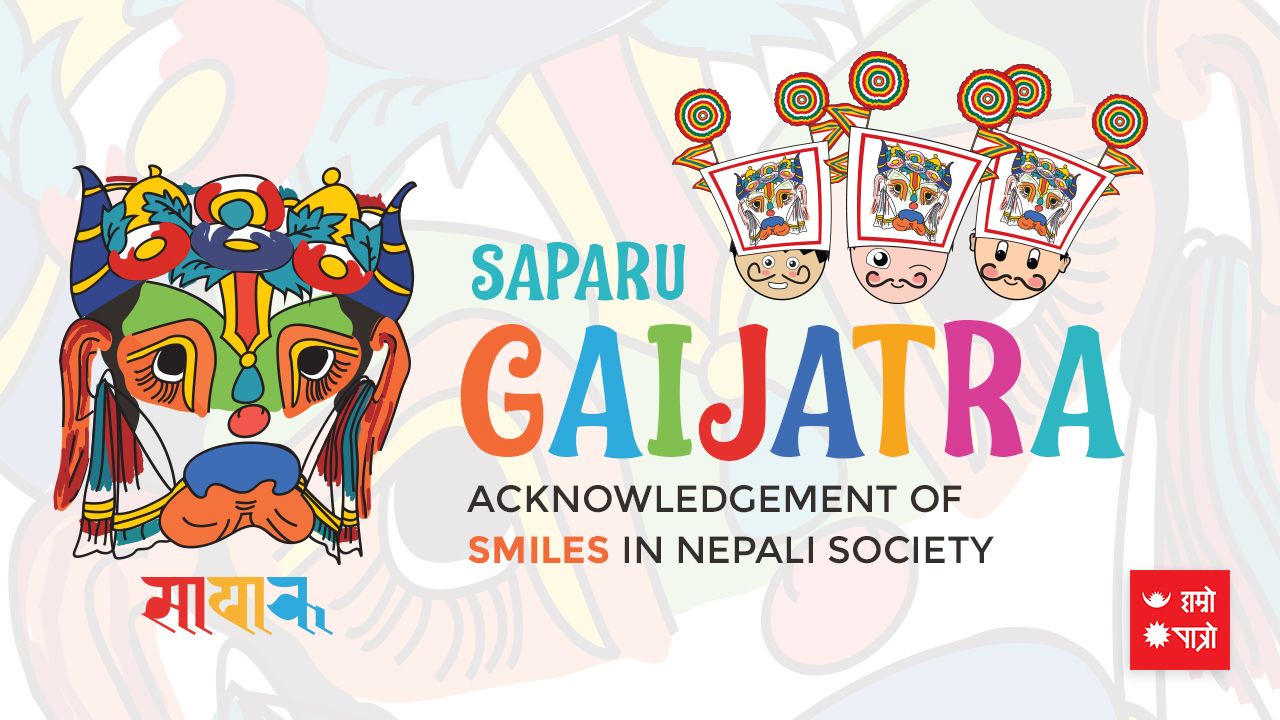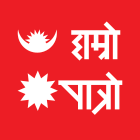Upcomming Events
-
24Paush
-
27PaushPrithivi Jayanti/Rashtriya Ekata Diwas/Gorakhkali Puja 3 days remaning
-
29PaushNational Bhakka Day 5 days remaning
-
30PaushShattila Ekadashi 6 days remaning
-
1MaghMakar Sankranti/Ghiu chaku khane Din/Uttarayan Arambha 7 days remaning
-
2MaghNational Earthquake Safety Day/Pradosh Vrata 8 days remaning
-
5MaghSonam Lhochhar/Shree Ballav Jayanti 11 days remaning
-
8MaghTilkunda Chauthi 14 days remaning
-
9MaghBasanta Panchami vrata/Saraswati Pooja 15 days remaning
-
10MaghSkanda Sasti/Achala Saptami/International Day of Education 16 days remaning
-
11MaghGorakhkali Puja/World Leprosy Day 17 days remaning
-
12MaghInternational Custom Day 18 days remaning
-
13MaghDron Nawami 19 days remaning
-
15MaghBhima Ekadashi Vrata 21 days remaning
-
16MaghSahid Diwas/Pradosh Vrata 22 days remaning
-
18MaghShree Swasthani Brata Samapti/Poornima Wrata 24 days remaning
-
19MaghWorld Wetlands Day 25 days remaning
-
21MaghWorld Cancer Day 27 days remaning
-
25MaghRavisaptami Vrata 31 days remaning
-
26MaghGorakhkali Puja 32 days remaning
-
28MaghInternational Day of Women and Girls in Science/Safer Internet Day 34 days remaning
-
1FalgunKumbha Sankranti/Bijaya Ekadashi Vrata/World Radio Day 36 days remaning
-
2FalgunShani Pradosh Vrata/Valentine's Day 37 days remaning
-
3FalgunMaha-Shivaratri / Army Day/Silachahre Puja 38 days remaning
-
6FalgunGyalpo Lhosar 41 days remaning
-
7FalgunPrajatantra Diwas / Election Day 42 days remaning
-
8FalgunWorld Day of Social Justice 43 days remaning
-
9FalgunInternational Mother Language Day 44 days remaning
-
12FalgunBhaumashtami Wrata/Gorakhkali Puja 47 days remaning
-
15FalgunAmalaki Ekadashi Vrata/World NGO Day 50 days remaning
-
17FalgunPradosh Vrata/Zero Discrimination Day 52 days remaning
-
18FalgunFagu Poornima / Holi/Poornima Vrata 53 days remaning
-
19FalgunFagu Poornima (Terai)/Khandagras Chandra Grahan/World Wildlife Day 54 days remaning
-
20FalgunTel Lagaune Ra Aapko Mujura Khane Din 55 days remaning
-
24FalgunInternational Womens Day 59 days remaning
-
27FalgunGorakhkali Puja 62 days remaning
-
1ChaitraMeen Sankranti/Paapmochini Ekadashi Brata/World Consumer Rights Day 66 days remaning
-
2ChaitraSom Pradosh Vrata 67 days remaning
-
3ChaitraPahachahre 68 days remaning
-
4ChaitraGhode Jaatra 69 days remaning
Jyotish
-
Jyotish Mohan Ghimireसम्पुर्णानन्द संस्कृत विश्वव...
-
Jyotish Vaman Sapkotaशिक्षा - व्याकरणाचार्य, पौरोही...
-
Jyotish Pandit Mukunda Nepalज्योतिष पण्डित मुकुन्द नेपाल�...
-
Jyotish Dipendra Khatiwadaसम्पुर्णानन्द संस्कृत बिश्वब...
-
Jyotish Damodar Poudelनेपाल संस्कृत विश्व बिद्यालय�...
-
 Jyotish Dharmendra Krishna Paudelशास्त्री धर्मेन्द्र कृष्ण पौ�...
Jyotish Dharmendra Krishna Paudelशास्त्री धर्मेन्द्र कृष्ण पौ�...
-
Jyotish Khageshwor Subediगुरुकुल पद्दति बाट ज्योतिषीय �...
-
Jyotish Narayan Prasad Bhandariज्योतिषका उप-प्राध्यापक (lecturer of A...
-
Jyotish Smarika Acharyaबाल्मीकि बिद्यापिठ बाट ज्योत�...
-
Jyotish Narayan Prasad Gautamगुरुकुल शिक्षा प्रणालीबाट ज्�...
-
Jyotish Hamro patroनेपाल संस्कृत विश्वविद्यालय �...
-
Jyotish Krishna Prasad Bhandariउपप्राध्यापक (Asst. professor of Sanskrit) नेपा�...
-
 Jyotish Mukunda Sharmaस्वाध्याय, सत्सङ्ग र सदाचारजस�...
Jyotish Mukunda Sharmaस्वाध्याय, सत्सङ्ग र सदाचारजस�...
-
Jyotish Purushottam Ghimireनेपाल संस्कृत विश्वविद्यालय, �...
-
Jyotish Amrit Paudelवाराणसीकै सम्पूर्णानन्द संस्...
-
 Jyotish Kuresh Pandey११ वर्षको अनुभवसहित विभिन्न ध�...
Jyotish Kuresh Pandey११ वर्षको अनुभवसहित विभिन्न ध�...
-
Jyotish Deepak Prasad Kafleसम्पूर्णानन्द संस्कृत विश्वव...
-
Jyotish Damodar Kaushikज्योतिष र व्याकरण विषयमा आचार�...
-
Jyotish Ghanashyam Pokharelनेपाल संस्कृत विश्वविद्यालयब...
Hororscope
Gaijatra: Acknowledgement of smiles in Nepali society.

Welcome to Gaijatra 2078 BS. From the Jatra of COVID, the evergreen Jatra of Nepali politics, the trending Jatra in Afghanistan on the world map now, the jatra of Syria and Libya, Jatras everywhere. Welcome to Gaijatra, a day of smiles that forgets these jatras of separation and destruction and transforms everything into simple happiness and harmony.
We are very rich in Nepali culture and traditions, every one of our festivals and rituals is piece of evidence before us, in various forms.
Our rituals are full of ownership, intimacy, and kinship, from animals to soil, from trees to leaves, and from raw cotton rope to the sun we have worshiped, and such rituals and ceremonies have been brought to you in detail by "Hamro Patro".
Probably the first essay written by many of us in student life was about cows. Not only the Vedic Sanatan rites but also the Indus Valley Civilization and in Bharat Barsa, the cow is worshiped as a symbol of special respect and faith in religious and cultural occasions in daily life. The Gaijatra festival is also an example of such cultural significance. This pilgrimage is very important especially for the family members who lost their loved ones in the last year as it is a special place of remembrance, affection, and closeness of the deceased.
In Nepal Bhasa, "Gaijatra" is called "Saparu". The streets are ablaze with cows, cow-disguises, and jhankis with various masks. In Gaijatra, various funny conversations, jokes, sarcasm, and even stand-up comedy are performed.
Considering the means of fun and laughter in the procession in memory of the deceased relatives, Gaijatra seems to call on the bereaved family of the deceased to move forward as a necessary process of life. Cow and Jatra i.e. this day is also the Jatra of cow revered in Hindu rites as mother and earth. According to legends written in the pages of history, the people of Kathmandu Valley worship Yama, the god of death, on this day. From BS 1641 to 1664, King Pratap Malla's queen was very much devastated by the death of her infant son.
Although the king tried to explain the fact that it was a moment that no one could control, the queen couldn't overcome the melancholy. Later, King came up with a plan which continues as Gaijatra even after hundreds of years.
King Pratap Malla called upon the relatives of the citizens who had died in the state during the year in which he lost his minor son to take a procession from the front of the palace with cows.
On this day, the procession was displayed in the present Kathmandu Durbar Square and the new exhibition caught everyone's attention. Seeing many family members who lost their loved ones in her memory, the queen felt that she was not the only one to mourn the death. As the king encouraged the people to include various jokes, senses of humor and acts in the procession, the queen largely laughed after seeing all these things.
On the other hand, the people who came in the procession started to symbolically explain the pomp of the rich people of the society and the suffering of the poor through various exhibitions and tableaus. That is to say, Gaijatra is also a festival of artistically exposing the negative aspects of the current social, cultural, and political activities in society.
At that time, the people satirically presented to the king and queen the examples of oppression and injustice done by the society towards the poor and helpless. The practice of bang, which was started in Gaijatra, has been passed down from generation to generation and is still practiced today to target politicians, media persons, and other eminent persons of the society.
No one is allowed to hold a grudge against the bang made in Gaijatra. When the cow is taken out, the cow is brought forward and if there is no cow, the Kumar boy is brought forward like a cow. Gaijatra is celebrated across Nepal.
On the other hand, Gaijatra also indicates that the monsoon end and festivals are approaching. The setting sun, the bright days, the chilling wind, and the finished planting of the field. In this sense, Gaijatra is also an opportunity to laugh freely on a leisurely day. There will be performances and gatherings of national and local artists from all over the country including Kathmandu. Such Gaijatra special programs last for 10 to 15 days.
TV, radio, and newspapers have been Gai Jatra filled during this period. From the Gulf to the United States, Europe, and Japan, Gaijatra is celebrated in various forms and formats wherever Nepalis are.
May this year's Gaijatra bring laughter and happiness to the mountains, hills, and the Terai. Let the perversion and corruption be exposed, let the transparency be praised. Smiles, smiles, and just smiles.
Suyog Dhakal
Upcomming Events
-
24Paush
-
27PaushPrithivi Jayanti/Rashtriya Ekata Diwas/Gorakhkali Puja 3 days remaning
-
29PaushNational Bhakka Day 5 days remaning
-
30PaushShattila Ekadashi 6 days remaning
-
1MaghMakar Sankranti/Ghiu chaku khane Din/Uttarayan Arambha 7 days remaning
-
2MaghNational Earthquake Safety Day/Pradosh Vrata 8 days remaning
-
5MaghSonam Lhochhar/Shree Ballav Jayanti 11 days remaning
-
8MaghTilkunda Chauthi 14 days remaning
-
9MaghBasanta Panchami vrata/Saraswati Pooja 15 days remaning
-
10MaghSkanda Sasti/Achala Saptami/International Day of Education 16 days remaning
-
11MaghGorakhkali Puja/World Leprosy Day 17 days remaning
-
12MaghInternational Custom Day 18 days remaning
-
13MaghDron Nawami 19 days remaning
-
15MaghBhima Ekadashi Vrata 21 days remaning
-
16MaghSahid Diwas/Pradosh Vrata 22 days remaning
-
18MaghShree Swasthani Brata Samapti/Poornima Wrata 24 days remaning
-
19MaghWorld Wetlands Day 25 days remaning
-
21MaghWorld Cancer Day 27 days remaning
-
25MaghRavisaptami Vrata 31 days remaning
-
26MaghGorakhkali Puja 32 days remaning
-
28MaghInternational Day of Women and Girls in Science/Safer Internet Day 34 days remaning
-
1FalgunKumbha Sankranti/Bijaya Ekadashi Vrata/World Radio Day 36 days remaning
-
2FalgunShani Pradosh Vrata/Valentine's Day 37 days remaning
-
3FalgunMaha-Shivaratri / Army Day/Silachahre Puja 38 days remaning
-
6FalgunGyalpo Lhosar 41 days remaning
-
7FalgunPrajatantra Diwas / Election Day 42 days remaning
-
8FalgunWorld Day of Social Justice 43 days remaning
-
9FalgunInternational Mother Language Day 44 days remaning
-
12FalgunBhaumashtami Wrata/Gorakhkali Puja 47 days remaning
-
15FalgunAmalaki Ekadashi Vrata/World NGO Day 50 days remaning
-
17FalgunPradosh Vrata/Zero Discrimination Day 52 days remaning
-
18FalgunFagu Poornima / Holi/Poornima Vrata 53 days remaning
-
19FalgunFagu Poornima (Terai)/Khandagras Chandra Grahan/World Wildlife Day 54 days remaning
-
20FalgunTel Lagaune Ra Aapko Mujura Khane Din 55 days remaning
-
24FalgunInternational Womens Day 59 days remaning
-
27FalgunGorakhkali Puja 62 days remaning
-
1ChaitraMeen Sankranti/Paapmochini Ekadashi Brata/World Consumer Rights Day 66 days remaning
-
2ChaitraSom Pradosh Vrata 67 days remaning
-
3ChaitraPahachahre 68 days remaning
-
4ChaitraGhode Jaatra 69 days remaning
Jyotish
-
Jyotish Mohan Ghimireसम्पुर्णानन्द संस्कृत विश्वव...
-
Jyotish Vaman Sapkotaशिक्षा - व्याकरणाचार्य, पौरोही...
-
Jyotish Pandit Mukunda Nepalज्योतिष पण्डित मुकुन्द नेपाल�...
-
Jyotish Dipendra Khatiwadaसम्पुर्णानन्द संस्कृत बिश्वब...
-
Jyotish Damodar Poudelनेपाल संस्कृत विश्व बिद्यालय�...
-
 Jyotish Dharmendra Krishna Paudelशास्त्री धर्मेन्द्र कृष्ण पौ�...
Jyotish Dharmendra Krishna Paudelशास्त्री धर्मेन्द्र कृष्ण पौ�...
-
Jyotish Khageshwor Subediगुरुकुल पद्दति बाट ज्योतिषीय �...
-
Jyotish Narayan Prasad Bhandariज्योतिषका उप-प्राध्यापक (lecturer of A...
-
Jyotish Smarika Acharyaबाल्मीकि बिद्यापिठ बाट ज्योत�...
-
Jyotish Narayan Prasad Gautamगुरुकुल शिक्षा प्रणालीबाट ज्�...
-
Jyotish Hamro patroनेपाल संस्कृत विश्वविद्यालय �...
-
Jyotish Krishna Prasad Bhandariउपप्राध्यापक (Asst. professor of Sanskrit) नेपा�...
-
 Jyotish Mukunda Sharmaस्वाध्याय, सत्सङ्ग र सदाचारजस�...
Jyotish Mukunda Sharmaस्वाध्याय, सत्सङ्ग र सदाचारजस�...
-
Jyotish Purushottam Ghimireनेपाल संस्कृत विश्वविद्यालय, �...
-
Jyotish Amrit Paudelवाराणसीकै सम्पूर्णानन्द संस्...
-
 Jyotish Kuresh Pandey११ वर्षको अनुभवसहित विभिन्न ध�...
Jyotish Kuresh Pandey११ वर्षको अनुभवसहित विभिन्न ध�...
-
Jyotish Deepak Prasad Kafleसम्पूर्णानन्द संस्कृत विश्वव...
-
Jyotish Damodar Kaushikज्योतिष र व्याकरण विषयमा आचार�...
-
Jyotish Ghanashyam Pokharelनेपाल संस्कृत विश्वविद्यालयब...
Hororscope
Liked by:


















 Mesh
Mesh Brish
Brish Mithun
Mithun Karkat
Karkat  Singha
Singha  Kanya
Kanya Tula
Tula Brischik
Brischik Dhanu
Dhanu  Makar
Makar  Kumbha
Kumbha Meen
Meen